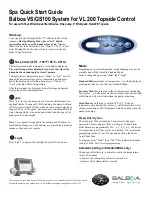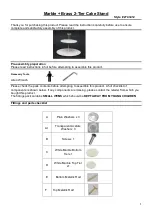
--9--
Connection of the
9-pole Plug-in Terminal Strip
(Sensor Inputs, Terminal)
:
Plug-in Terminal Strip:
In case of limited space, the strip can be
removed
and
reinserted
at any time for easy cable
connection.
Cable Cross-Sections:
0,75 mm
2
or more.
Length to be stripped
: approx. 6 mm.
Protection:
All inputs and outputs of this terminal strip are protected against overvoltage, reverse battery and
overload.
"D+":
Control input from the generator for function
on/off
:
Connect the terminal "D+" directly to the existing signal in the vehicle. The D+ signal is preferably to be used for the "active
generator".
If the D+ signal does not exist in the vehicle, the signal "Ignition ON" (terminal 15) can be used for unit control. However:
Warning:
When the engine is not running, the starter battery might be discharged!
In case of pure
voltage control
of the unit, table 4, items 1. and 2., the terminal is to be left blank.
"Vs -"
and
"Vs +": IN
Input voltage sensor/sense cables to the
STARTER
battery (option):
Measuring inputs for accurate battery
input voltage
:
With it, the unit is able to measure the exact voltage of the STARTER battery, independently of the voltage losses on the
supply cables, and to draw conclusions from it concerning the condition of the STARTER battery (such as rating).
For this, connect the sense cables "Vs-" and "Vs+" directly to the poles of the STARTER battery.
Never
connect them to the
interconnected distributors, ground or the like (voltage falsification)!
The cables are not required, if the values in the
tables 1
for "
cable length "+ START"
are only used to approx. 3/4. Then,
leave the terminals blank.
Never mix up the sensor cables
Start IN
("Vs-"/"Vs+") and
Board OUT
("Vb-"/"Vb+"),
otherwise the voltage control of the unit will be led astray!
"TR":
Terminal for external bridging relay, see page 7, Special Case
"TR Bypass Relay in case of temporarily very high consumer current rates".
If not used,
leave the terminal blank.
The rating of the
output
is
max. 1 A
, and it is protected with a thermal fuse, which resets itself after removal of the
overload and reactivates the output.
"CI":
Connection without function, leave the terminal blank.
"T T":
Measuring input for the
temperature
of the
board
supply battery:
Connect the temperature sensor to
the terminals "T T"
(any polarity). Further details concerning the functions of the
sensor can be found under the paragraph "
Battery Temperature Sensor
" and in the charging characteristic lines.
"Vb -"
and
"Vb +": OUT
Output voltage sensor/sense cables to the
board
battery (option):
Measuring inputs for exact measurement of the
board
battery voltage (output voltage):
The unit uses the sense cables for the exact measurement and control of the charging voltage at the board battery to be
charged, independently of the voltage losses on the charging cables. For this, connect the sense cables "Vb-" and "Vb+"
directly to the poles of the board battery.
Never
connect them to the interconnected distributors or the like (voltage
falsification)!
The cables are not required, if the values in the
tables 1
for "
cable BOARD"
are only used to approx. 3/4. Then,
leave the terminals blank.
Never mix up the sensor cables
Board OUT
("Vb-"/"Vb+") and
Start IN
("Vs-"/"Vs+").
Otherwise the voltage control of the unit will be led astray!
If several batteries are connected in parallel as battery system (battery bank), cross connection is required:
Connect "Vb-" to the negative pole of the 1
st
battery.
Connect "Vb+" to the positive pole of the 2
nd
or last battery of the system.
The charger will automatically recognize and evaluate the sensor cables.
If the sensor cables are not installed,
or in case of a cable break or fuse failures, it will be switched to
normal operation with charging cable compensation, that means, the calculated compensation of the
voltage losses on the charging cables within the values in the
tables 1
.






































